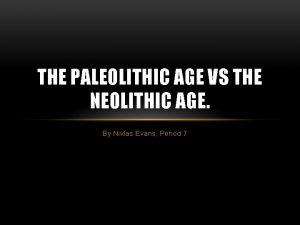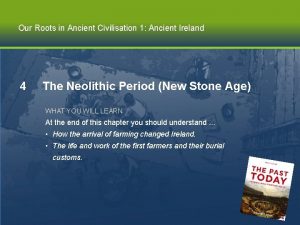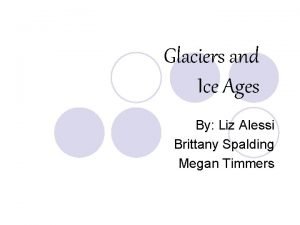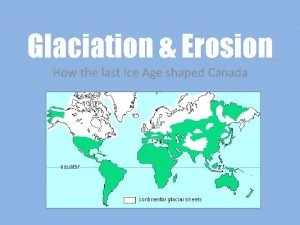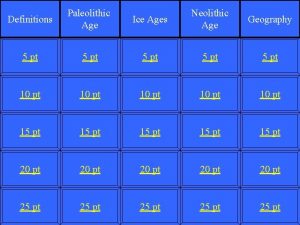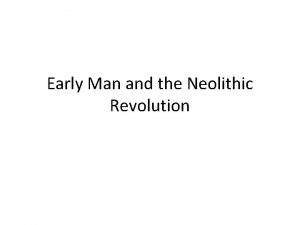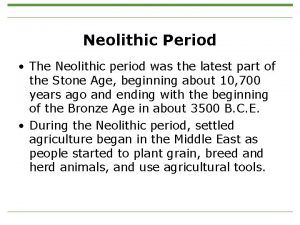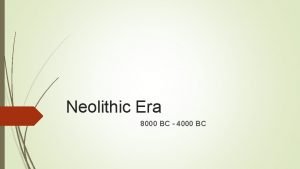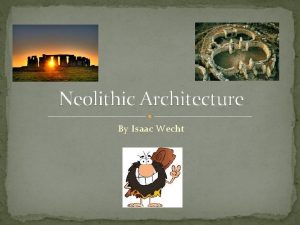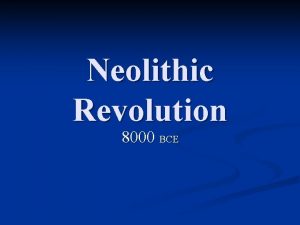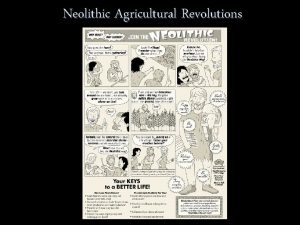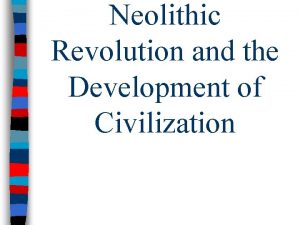Neolithic Age Neolithic END OF THE ICE AGE


























- Slides: 26

Neolithic Age

Neolithic • END OF THE ICE AGE (an environmental paradigm shift) • Domestication of dogs and plants • Everybody settles down • Agriculture and stock raising • Happens first in the Middle East 2

Mud-brick houses At Jericho 8000 BCE This is the remains Of the tower that Was part of the Wall around the Town. There is a Stairway inside to The top. Beginning Of monumental architecture Figure 1 -14 Great stone tower built into the settlement wall, Jericho, ca. 8000– 7000 BCE. 3

At this settlement: figures Buried in ritual-made of A reed-twine core and covered In plaster-some were 3 ft high! Beginning of monumental sculpture. ! Figure 1 -15 Human figure, from Ain Ghazal, Jordan, ca. 6750– 6250 BCE. Plaster, painted and inlaid with cowrie shell and bitumen, 3’ 5 3/8” high. Louvre, Paris. 4

The beginning of Humans in boxes… And clever boxes they were… Figure 1 -16 Schematic reconstruction drawing of a section of Level VI, Çatal Höyük, Turkey, ca. 6000– 5900 BCE. (after J. Mellaart). 5

Neolithic Dwellings contained: • Platforms for sleeping where the dead were buried. • Decorated rooms that might have been shrines with bovine skulls and plaster breasts. • Small Female statues • Plaster Wall paintings done with brushes of hunting scenes: with a big change: there are multiple people now. – Style characteristics of Neo wall paintings: • • Rhythmic repitition of people Animated varied poses Details like chins and hair Informative viewpoint (composite view: head from the side and torso from the front) 6

Figure 1 -17 Deer hunt, detail of a wall painting from Level III, Çatal Höyük, Turkey, ca. 5750 BCE. Museum of Anatolian Civilization, Ankara. 7

The earliest landscape known to be painted by a human hand. This image of a volcano erupting with the town in front looks to have Been inspired by a real double-peaked volcano in full view of the town 8

Figure 1 -19 Aerial view of Stonehenge, Salisbury Plain, Wiltshire, England, ca. 2550– 1600 BCE. Circle is 97' in diameter; trilithons approx. 24' high. 9

A henge is an arrangement Of megalithic stones in a circle. Usually surrounded by a ditch. Figure 1 -19 Detail major trilithon, from NW This was made of sandstone & Bluestone over a period of Hundreds of years. This is a trilithon made from Post and lintel construction. EACH STONE WEIGHTED 50 TONS (as much as a whale, A crane, or the Washington Monument) and was placed according to A human compass. These stones came From 23 miles away. (that is roughly The distance from here to Kings Dominion and back) The heelstone stands apart and If viewed from the center-faces The sunrise at the summer © 2005 Saskia Cultural Documentation, Ltd. solstice 10

• Used for burial of men • Three phases of construction over 100 s of years • A solar and lunar calendar? The main stones line up with the sun at the moments of the summer and winter solstices

• Stele: A stele is a vertical stone monument or marker often inscribed with text or relief carving.

• evidence of stylistic influence, coupled with the presence of exogenous materials (materials that originated elsewhere), confirm that during the Neolithic period objects were circulated and exchanged across wide swathes of territory.

• Archaeologists believe that the Ha’il stele was probably associated with religious or burial practices, and was likely used as a grave marker in an open-air sanctuary. While we do not know who produced the stele (just imagine a specialist stone carver working among mobile pastoral herders), we continue to be intrigued by the quality of the carving and its minimalist, yet expressive, representation of the human figure.





• Bi disks found as well…. laid on the dead in tombs…also just 7 inches in diameter…. .







 Paleolithic vs neolithic
Paleolithic vs neolithic Last ice age
Last ice age Iron age bronze age stone age timeline
Iron age bronze age stone age timeline Stone age, bronze age iron age timeline
Stone age, bronze age iron age timeline Icing
Icing Clear ice vs rime ice
Clear ice vs rime ice Neolithic
Neolithic Court tombs ireland
Court tombs ireland Old stone age characteristics
Old stone age characteristics Birth of agriculture
Birth of agriculture Neolithic age
Neolithic age What change began the neolithic age, about 8000 b.c.e.? *
What change began the neolithic age, about 8000 b.c.e.? * Some say the world will end in fire some say in ice
Some say the world will end in fire some say in ice Fire and ice diamante poem
Fire and ice diamante poem Liz ice age
Liz ice age Ice age crack
Ice age crack 5 major ice ages
5 major ice ages Ice age migration
Ice age migration Ice age sheep
Ice age sheep Last ice age
Last ice age What do you mean by the front end in the compiler design?
What do you mean by the front end in the compiler design? End to end
End to end End to end accounting life cycle tasks
End to end accounting life cycle tasks Stroke volume units
Stroke volume units Feride kröpil
Feride kröpil Comet transformer
Comet transformer Protect
Protect
